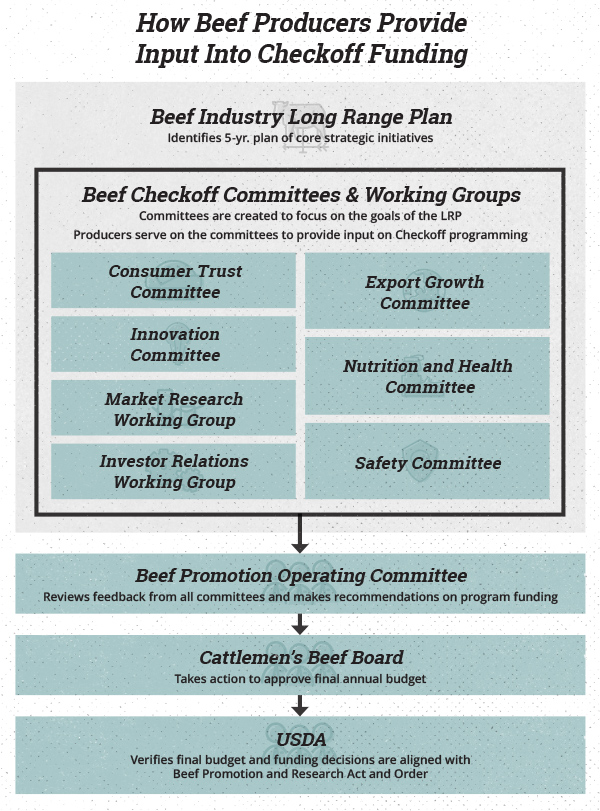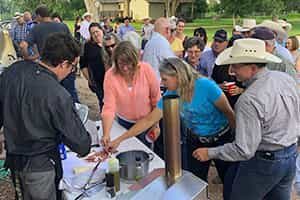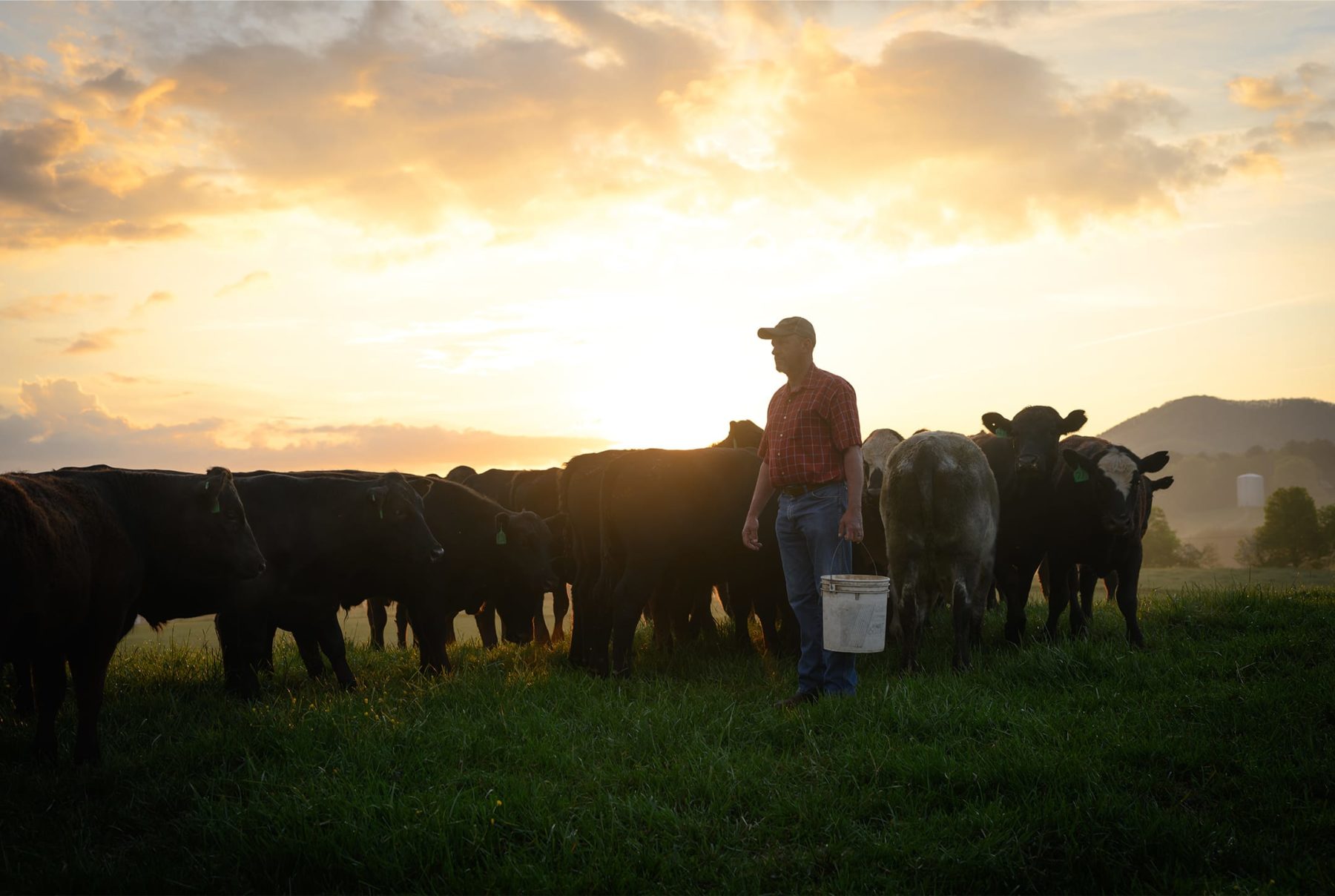In the few months since I took the helm as CEO of the Cattlemen’s Beef Board (CBB) – the governing and administrative organization of the Beef Checkoff – there appears to be many misperceptions, false rumors, and misinformation about how the checkoff works and is administered. Let’s look at its history, what the Beef Checkoff can and cannot do, as well as the processes and procedures we have in place to continue to be strong stewards of your checkoff dollars.
 THE CREATION OF THE BEEF CHECKOFF
THE CREATION OF THE BEEF CHECKOFF
The Beef Checkoff was created through the Beef Promotion and Research Act of 1985 as part of the Farm Bill. It was initiated as an effort driven by producers who saw an important need for more promotion and research to stave off falling beef demand in the late 1970s / 1980s and was designed to be producer driven at both a local and national level. Immediately following its passing, the Beef Promotion and Research Order was created, outlining the detailed rules for governance over the program, funding distribution, contractor requirements, etc. The areas where checkoff funding can be used are clearly defined: promotion, research, consumer information, industry information, and producer communications. Conversely, lobbying or “influencing governmental action or policy” is also clearly prohibited.
Within 22 months, a referendum was conducted among producers throughout the U.S. to vote on the continuation of the program – which was passed by 79% of farmers and ranchers. The Beef Checkoff as we know it came life in 1988. Copies of both “The Act and Order” are available online at beefboard.org/beef-act-and-order, or you can contact our office and we can ensure you get a copy.
USDA OVERSIGHT
The Act and The Order is our rulebook – set in law – that we must follow every day. To ensure all aspects of this law are followed, the USDA is delegated authority by Congress to oversee the Beef Checkoff Program. As part of its oversight responsibilities, USDA reviews and approves our plans, projects, budgets, contracts, processes and procedures, and keeps a watchful eye over our financials, our board, our communications, and our operations. In fact, the Secretary of Agriculture himself appoints all 99 CBB board members, which includes both domestic producers and importers, a process outside of our purview.
CATTLEMEN’S BEEF BOARD
The Act and The Order outlines additional specifics about the governance supporting your checkoff dollars. As noted, they outline the type of activities that can/cannot be funded; define that all efforts must be producer-driven; that the CBB board members must be producers and importers who serve on the national board in a voluntary capacity for 3-year terms; that no member shall serve more than two consecutive terms; and that the number of board members are based on the cattle inventory of each state.
BEEF PROMOTION OPERATING COMMITTEE
Another piece outlined by The Act and The Order is the Beef Promotion Operating Committee. This important group of 20 producers and importers is created by appointed positions from the Cattlemen’s Beef Board (10 members) and the Federation of State Beef Councils (10 members). This committee oversees the distribution each year of nearly $40 million of national Beef Checkoff dollars to beef industry contractors to do the work outlined in The Act and The Order. Funding decisions must be made together by both national and state-level decision-makers, with great consideration to the balance between the national and regional needs of producers. No funding decision can be made without approval from at least two thirds, or 14 of the Operating Committee members, so neither the CBB nor the Federation can dictate where funding goes. As such, programs must show great benefit to the industry as a whole to get approved.
BEEF CHECKOFF CONTRACTORS
The Beef Checkoff currently partners with eight national non-profit, beef industry-governed organizations we call contractors. All contractors are vetted, audited, and reviewed regularly by the Cattlemen’s Beef Board. Each contractor must meet specific criteria to receive Beef Checkoff funding, a process that can take up to a year to facilitate. In fact, the U.S. Cattlemen’s Association just became a new contractor this year.
The Act and The Order states that contractors to the checkoff be national non-profit industry-governed organizations that are governed by a board of directors representing the beef industry, and have been active and ongoing for at least two years. All contractors work on a cost-recovery basis, meaning they must do the work outlined in their funding request and then seek reimbursement for their costs. This allows for the Cattlemen’s Beef Board to have direct oversight of expenses that use checkoff funds. If expenses are submitted that do not meet The Act and The Order, they are not reimbursed. Thus, the checkoff does not pay for anything it should not. In addition, if a contractor has a lobbying arm, they must prove they have an accounting “firewall” between their checkoff and lobbying dollars. The Cattlemen’s Beef Board works closely with these organizations so that checkoff dollars aren’t used outside of the scope of the Act and Order.
Our eight contracting organizations for Fiscal Year 2020 (Oct. 2019 – Sept. 2020):
- American Farm Bureau Foundation for Agriculture
- Cattlemen’s Beef Board
- Foundation for Meat and Poultry Research and Education
- Meat Import Council of America
- National Cattlemen’s Beef Association
- National Livestock Producers Association
- North American Meat Institute
- United States Cattlemen’s Association
In addition, our contractors work with four subcontracting organizations:
- Kansas State University
- North East Beef Promotion Initiative
- National Institute for Animal Agriculture
- United States Meat Export Federation
The Beef Checkoff plays an extremely important role in providing education and driving demand for our beef. Competition is fierce among proteins in the United States and global markets now, so we are proud of our contractors and the work they do every day to ensure beef continues to be the number one protein to consumers everywhere. We have small contractors and large ones; we have contractors with very targeted audiences, and those who reach large swaths of the population. Whether building a promotional campaign, researching nutrition and health, championing handling and safety, or engaging consumers, together they each play an important role in driving beef demand, both here in the United States as well in the international markets.
Visit DrivingDemandForBeef.com for more information on the Beef Checkoff, Cattlemen’s Beef Board, Qualified State Beef Councils, and Beef Checkoff contractors.
 The national Beef Checkoff was established as part of the 1985 Farm Bill and initiated by beef producers when 79 percent voted to make the Checkoff mandatory in a 1988 national referendum. To this day, the Checkoff is still producer-led. To accomplish the goals and objectives of the Beef Industry Long Range Plan, Checkoff committee members from the Cattlemen’s Beef Board (CBB) and the Federation of State Beef Councils collaborate together to drive demand for beef.
The national Beef Checkoff was established as part of the 1985 Farm Bill and initiated by beef producers when 79 percent voted to make the Checkoff mandatory in a 1988 national referendum. To this day, the Checkoff is still producer-led. To accomplish the goals and objectives of the Beef Industry Long Range Plan, Checkoff committee members from the Cattlemen’s Beef Board (CBB) and the Federation of State Beef Councils collaborate together to drive demand for beef. The Beef Promotion Operating Committee has 20 members, 10 of whom are elected to serve by the Cattlemen’s Beef Board, while the other 10 are selected by the states through the Federation of State Beef Councils. No program is approved unless two-thirds of the members of the Operating Committee vote to accept it. This means a program must have recognized value to earn the consensus needed for funding.
The Beef Promotion Operating Committee has 20 members, 10 of whom are elected to serve by the Cattlemen’s Beef Board, while the other 10 are selected by the states through the Federation of State Beef Councils. No program is approved unless two-thirds of the members of the Operating Committee vote to accept it. This means a program must have recognized value to earn the consensus needed for funding. 



 THE CREATION OF THE BEEF CHECKOFF
THE CREATION OF THE BEEF CHECKOFF
 On August 8, during the 79th Sturgis Motorcycle Rally, the South Dakota Beef Industry Council (SDBIC) hosted two separate events—one highlighting SDBIC’s consumer-focused beef promotion competition the “Sturgis® Beef Throw Down!” and the second educating beef producers on the importance of promoting beef in unique ways.
On August 8, during the 79th Sturgis Motorcycle Rally, the South Dakota Beef Industry Council (SDBIC) hosted two separate events—one highlighting SDBIC’s consumer-focused beef promotion competition the “Sturgis® Beef Throw Down!” and the second educating beef producers on the importance of promoting beef in unique ways. Area producers gathered later that evening at the Mt. Rushmore Angus Ranch near Hermosa, South Dakota, to learn about the efforts the Beef Checkoff and SDBIC are making to drive beef demand. Greg Hanes, CEO of the Cattlemen’s Beef Board (CBB), was in attendance to share his vision for the Beef Checkoff and answer producer questions about the program and its initiatives. During the evening’s event Warner demonstrated the different ways he is cooking beef to widen its appeal to consumers.
Area producers gathered later that evening at the Mt. Rushmore Angus Ranch near Hermosa, South Dakota, to learn about the efforts the Beef Checkoff and SDBIC are making to drive beef demand. Greg Hanes, CEO of the Cattlemen’s Beef Board (CBB), was in attendance to share his vision for the Beef Checkoff and answer producer questions about the program and its initiatives. During the evening’s event Warner demonstrated the different ways he is cooking beef to widen its appeal to consumers.

